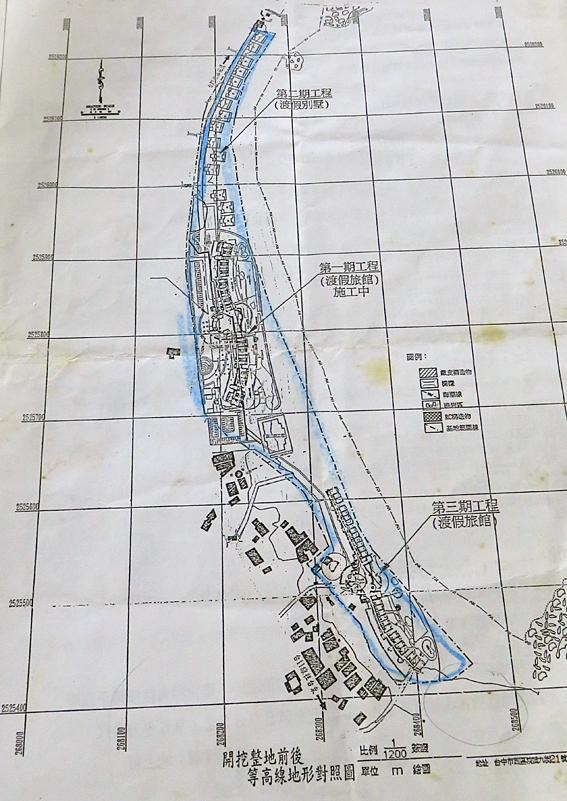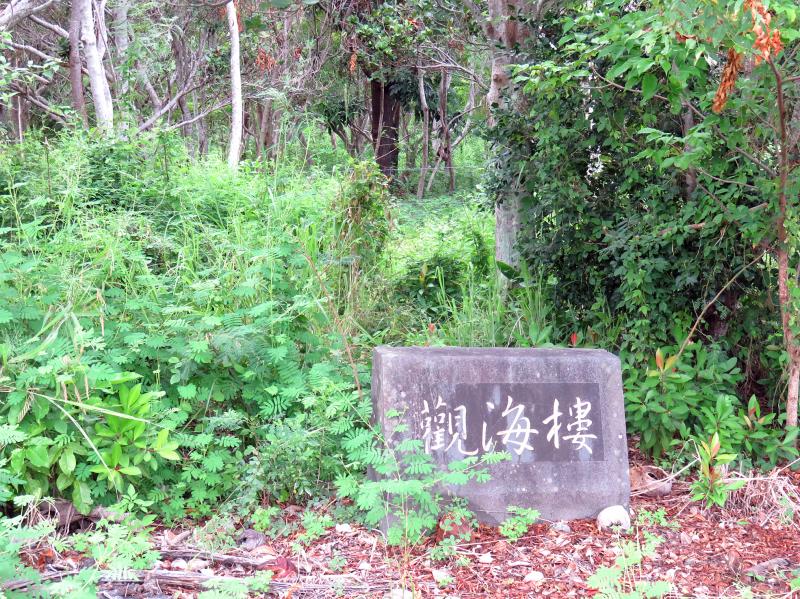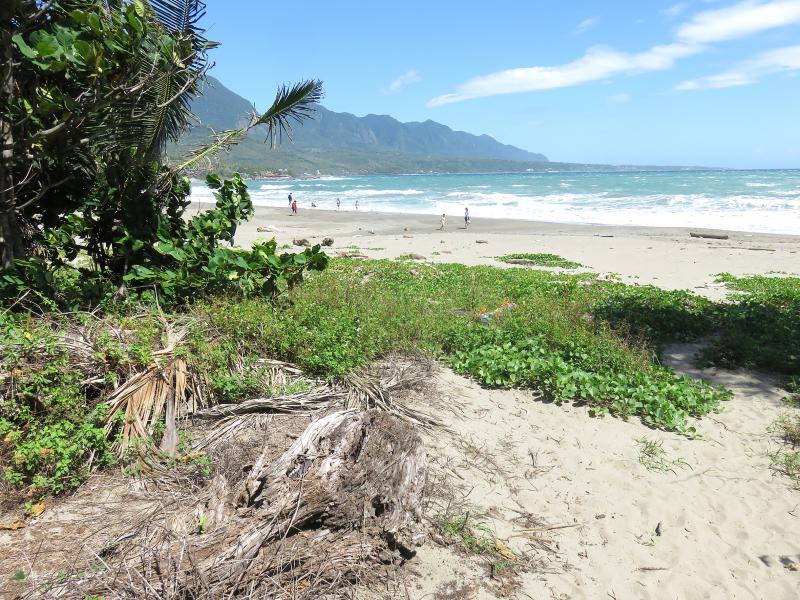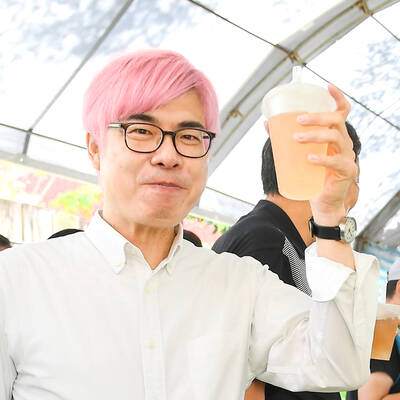It’s not even a road yet. At the moment it is merely a hint of upturned sod off Highway 11. When I visited last week the digger was sitting there unattended for the holiday. And yet, there it was, terrifying.
On the site plan the locals obtained, the road goes down to the south end of Taitung County’s Shanyuan (杉原) Beach. That beach now hosts the infamous Miramar hotel, built on land taken from aborigines by the government in 1987 and handed over to a developer to build a hotel in 2004 as a build-operate-transfer (BOT) project.
The hotel became the focus of a bitter struggle between environmentalists and developers over the potential destruction of one of the most beautiful and unique stretches of beach and bay in Taiwan, where the coast’s notorious rip is far from the beach, and Indian Ocean corals and sea turtles may be found.

Photo: Michael Turton
Today the abandoned Miramar is a ghastly bright corpse in the center of the beach, a bit back from the water, but not out of the reach of typhoons. It was repurchased from the developer by the county government last year, seemingly ending the long battle. The building is empty, but part of the parking lot is used.
Originally the Miramar plans called for villas running north from the main building, and to the south, much closer to the water on a shelf of sand, another hotel building, roughly the size of the first. That second building, as one quickly learns when walking over the area, would have been an easy target for a big typhoon.
The villas were given up first as the developer attempted to compromise with environmentalists and keep the main building. The second was never started.

Photo: Michael Turton
The original plans also called for a long, high wall to seal off the local community, Fushan (福山) in Beinan Township (卑南), from the beach. Comically, locals were assured they could still access the beach by walking around the community along Hwy 11 to the hotel and then cutting through the parking lot. That was all defeated.
The new road, still in its infancy, follows the southernmost access road from Highway 11 on the old plans for the second Miramar building. The second stage of its plan has the road turning north parallel to the shoreline, roughly following the old second hotel’s access road, swinging around the community along the beach, then hooking up with the existing Miramar parking lot.
That new road will be built next to the sand, in a stretch where typhoons regularly deposit large chunks of driftwood and other objects. Buried in a clump of trees where the road will pass are the remains of concrete foundation that slid into the sand after a storm. The locals I talked to are all convinced that the first big typhoon will take that road out.

Photo: Michael Turton
They are also suspicious that losing the road is part of the plan. Then the contractors will argue that they have to repair it and add a seawall or big concrete jacks to protect it. That road-and-wall combination will effectively isolate the community. It will then be much easier to build something on the beach.
When the Miramar was first constructed, several homes were in the zone slated for demolition. Those individuals were simply given eviction notices, with no explanation, warning or promises of help. That is what sparked the locals to learn to fight back.
For the road, things are similarly mysterious. There is no notice board describing the project near where the digger is working. The locals assured me that none of them has heard of an Environmental Impact Assessment (EIA) for it.

Photo: Michael Turton
Taiwan’s morass of land ownership, authority, and local corruption makes this possible. The central government has immense power but it is distant.
Fushan is home to an Amis indigenous community, who call it Fudafudak. The residents are “squatters” on land owned by the county and central governments. Years ago some people were able to obtain title, but many did not. Shanyuan Beach was once part of their traditional fishing grounds. Today they are struggling to find land for homes for their young people.
Ironically, they are “squatters” on what was once their own land, though some of the houses have been there nearly 90 years. Because they are “squatters,” they are at the mercy of any developer who can convince the local government to part with the land.

Photo: Michael Turton
Quite the romance: development and colonialism, holding hands and walking on the beach.
I borrowed a scooter and zoomed up Hwy 11. Just north of the hotel, where there is a stretch of coral rocks on the beach, the government is constructing a wastewater processing plant right on the beach.
“For the local community,” I was told by one of the workers.
A quick scooter trip into the hills above and around the beach suggested something else: four or five large hotels are going up in those hills. The defeat of the Miramar had a salutary effect: it gave the developers pause and work on the hotels was halted.
Today work is resuming. I scootered up to a place where there used to be a wooden observation tower with an excellent view of the bay. Now the tower site is cleared ground, though the marker for it is still there. Behind the marker a simple wire fence marks the land that will host a new hotel. The builders have slashed roads through the brush and trees on the slope.
It is obvious what wastewater is going to go into that plant: hotel wastewater. The plant sits right on the bay, and the wastewater will likely be dumped right into it. Indeed, a giant hole has already been dug in the sand for the project.
Once the bay is destroyed, there will be much less incentive to protect anything that is left. Then the developers can move in. The new road will then be there next to the beach, a ready link to a new project on that shelf of sand the last developer looked so hungrily at.
Today the Miramar sits, waiting. The locals assure me that nothing has ended. The developers will simply wait them out. The county will eventually sell off the building to another developer, they say, and the cycle of destruction will begin anew.
The developers can wait forever, if necessary. The media will move on, the activists turn to something else, the locals refocus on their lives, but the developers?
Developers are as inexorable as death.
Notes from Central Taiwan is a column written by long-term resident Michael Turton, who provides incisive commentary informed by three decades of living in and writing about his adoptive country. The views expressed here are his own.

The Taipei Times last week reported that the rising share of seniors in the population is reshaping the nation’s housing markets. According to data from the Ministry of the Interior, about 850,000 residences were occupied by elderly people in the first quarter, including 655,000 that housed only one resident. H&B Realty chief researcher Jessica Hsu (徐佳馨), quoted in the article, said that there is rising demand for elderly-friendly housing, including units with elevators, barrier-free layouts and proximity to healthcare services. Hsu and others cited in the article highlighted the changing family residential dynamics, as children no longer live with parents,

It is jarring how differently Taiwan’s politics is portrayed in the international press compared to the local Chinese-language press. Viewed from abroad, Taiwan is seen as a geopolitical hotspot, or “The Most Dangerous Place on Earth,” as the Economist once blazoned across their cover. Meanwhile, tasked with facing down those existential threats, Taiwan’s leaders are dying their hair pink. These include former president Tsai Ing-wen (蔡英文), Vice President Hsiao Bi-khim (蕭美琴) and Kaohsiung Mayor Chen Chi-mai (陳其邁), among others. They are demonstrating what big fans they are of South Korean K-pop sensations Blackpink ahead of their concerts this weekend in Kaohsiung.

Taiwan is one of the world’s greatest per-capita consumers of seafood. Whereas the average human is thought to eat around 20kg of seafood per year, each Taiwanese gets through 27kg to 35kg of ocean delicacies annually, depending on which source you find most credible. Given the ubiquity of dishes like oyster omelet (蚵仔煎) and milkfish soup (虱目魚湯), the higher estimate may well be correct. By global standards, let alone local consumption patterns, I’m not much of a seafood fan. It’s not just a matter of taste, although that’s part of it. What I’ve read about the environmental impact of the

Oct 20 to Oct 26 After a day of fighting, the Japanese Army’s Second Division was resting when a curious delegation of two Scotsmen and 19 Taiwanese approached their camp. It was Oct. 20, 1895, and the troops had reached Taiye Village (太爺庄) in today’s Hunei District (湖內), Kaohsiung, just 10km away from their final target of Tainan. Led by Presbyterian missionaries Thomas Barclay and Duncan Ferguson, the group informed the Japanese that resistance leader Liu Yung-fu (劉永福) had fled to China the previous night, leaving his Black Flag Army fighters behind and the city in chaos. On behalf of the